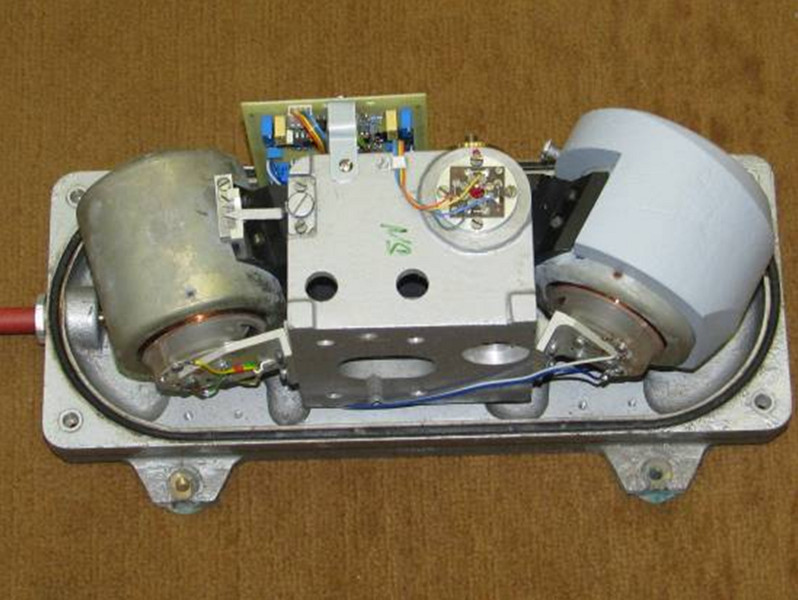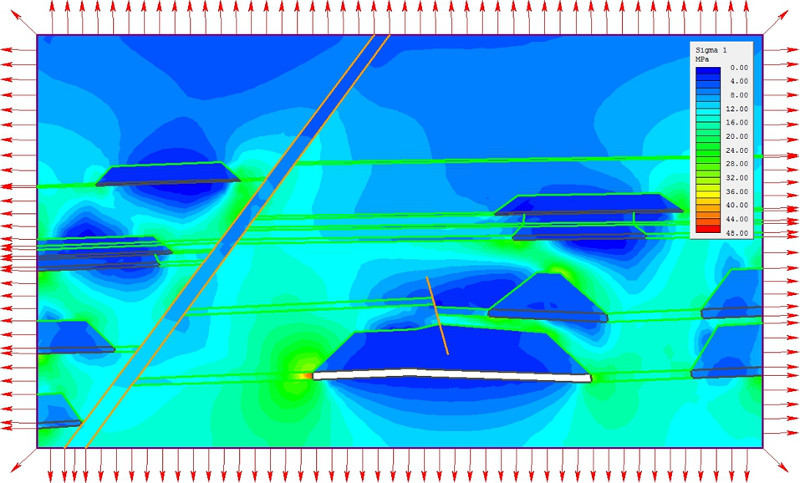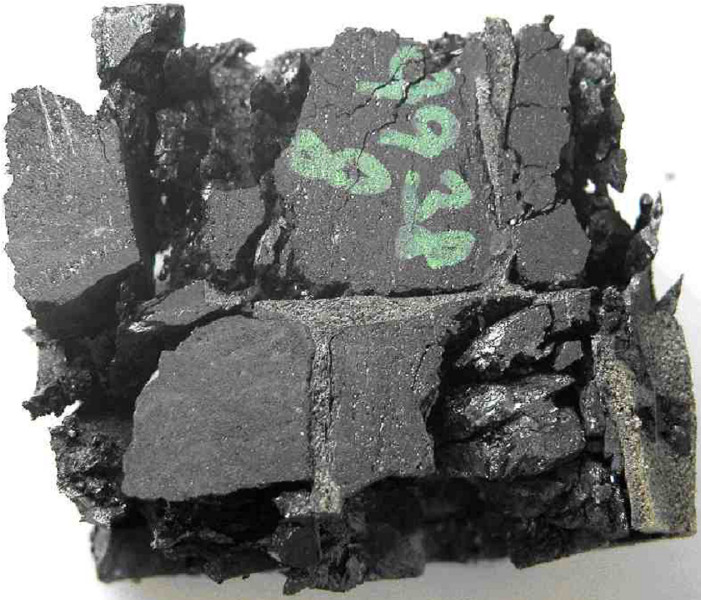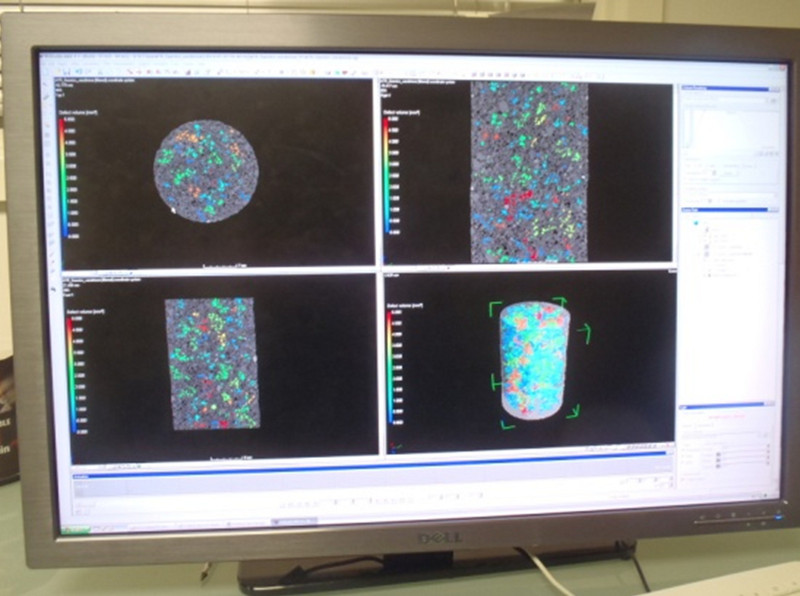Department of geomechanics and mining research
| RNDr. Lubomir Stas, CSc. | ||
| Mgr. Andrea Bercakova Ing. Hana Dolezalova, Ph.D. Anna Dombkova Ing. Lucie Georgiovska RNDr. Jan Chura Ing. Vlastimil Kajzar, Ph.D. Ing. Tomas Kalab Prof. RNDr. Zdenek Kalab, CSc. | Jan Klos Doc. Ing. Petr Konicek, Ph.D. Ing. Radovan Kukutsch, Ph.D. Ing. Marketa Lednicka, Ph.D. Jaroslav Makovsky Zdenek Nohejl Ing. Alice Petrlikova Jana Rusajova | Tomas Rutar Ing. Kamil Soucek, Ph.D. Tomas Soucek Ing. Jarmila Simkovicova Doc. Ing. Richard Snuparek, CSc. Ing. Martin Vavro, Ph.D. Ing. Petr Waclawik, Ph.D. Ing. Vendula Zajicova |
The department continues to do research in both directions, which have been pursued at the institute since its inception (rock mass stress and its effects, the stability of mining conditions, applications in mining and geotechnics) but also develops research in other fields, from influencing the rock mass properties to the use of methods of computer tomography. In 2012, a merging with the Department of Geophysics occurred with the aim of interconnecting activities in the research of in-situ rock mass and the Earth's crust and methods of monitoring processes in the geological environment. This made the research plans even broader.
Main research topics
The department focuses on the research of the geomechanical and geophysical processes in the Earth´s crust. They are both natural processes, but mainly processes induced by human activity associated with the exploitation of the Earth's crust. The department has carried out both long-term scientific research (e.g. the measurement and interpretation of stress fields, the observation and interpretation of seismicity in Northern Moravia), as well as practical solutions to current problems in the areas of the underground mining of deposits, underground constructions, reservoirs, the underground storage of spent nuclear fuel, CO2, etc.
The department staffs are involved in many research and application projects. Particularly important is the participation in the project The Institute of clean technologies for the extraction and use of energy resources, (ICT) with joint participation from the Technical University of Ostrava. Involvement in this project provides for; inter alia, the building of a special laboratory for the tomographic research of rocks and other materials. Other major projects are focused on the construction of underground repositories, whether radioactive waste or energy resources (gas, compressed air), and the issue of safe mining.
The investigation of stress and strain states in the rock massif. The aim is the determination of the spatial distribution, size, and orientation of natural and induced stress fields dependant on the geological and tectonic situation, anthropogenic activities in the massif, and the analysis of its manifestations. This research is aimed at:
- identifying the actual stress field in the rock mass and its changes by hydrofracturing;
- using the conical gauge probe and gauge studs;
- geomechanical monitoring, measuring the deformation of the underground spaces, and the analysis of the stability conditions;
- the application of mathematical models in geomechanics and geotechnics, with an emphasis on examining the processes in rocks and soils from the engineering point of view;
- dynamic geomechanical phenomena in the rock mass;
- the influence of geological and anthropogenic activities on the ground motion.
The investigation of reinforcing methods and the projected adjustment of the rock mass properties. The investigation of reinforcing methods and the projected adjustment of the rock mass properties mean:
- the development of modern methods of stabilizing the massif, especially by chemical grouting media, bolting and anchoring, or by combination of the two processes, respectively;
- the study of the properties of used grouting media – chemorheology, elasticity, strength, deformability, penetrability, depending on various parameters of the application;
- the preparation and study of physico-mechanical properties of the resulting geocomposites, including adhesion strength;
- grout flow in porous and discontinuous material;
- the verification of technological procedures;
- the design and evaluation of real projects of reinforcing by chemical grouting, bolting and anchoring or a combination of the two, in terms of geotechnical stability and the functionality of the underground structures, measuring of the resistance of bolted reinforcement.
The research methods of projected influence of hazardous stress states in the massif. The focus of this research is on non-excavating blasting in rock masses, which, in the conditions of the Czech part of the Upper Silesian Coal Basin, is one of the most important means of active rock burst prevention. It is implemented in coal seams and accompanying rocks. The evaluation of the effectiveness of non-excavating blasting in terms of releasing concentrations of stress is an important part of rock-burst prevention. The current rating system of efficiency is realized on the basis of data collected from seismic monitoring. The research is focused on the parameters applicable to the evaluation of efficiency (registered seismic energy magnitude, maximum volume changes in the focal area), natural conditions, and the technical parameters of realized non-excavation blasting.
Monitoring and interpretation of seismicity in Northern Moravia. The seismicity of Northern Moravia is caused by natural earthquakes and by mining-induced phenomena. Natural earthquakes are monitored by three solitary stations operated by the Ostrava institutional station Krasne Pole (belonging to the Czech Regional Seismic Network and operated in collaboration with VSB-TU). Interpreted data are transferred to the centre of the Czech National Seismic Network and are available on the Institute web pages. The aim of monitoring is to obtain information for determining the seismic activity in Northern Moravia. The interpretation of the data is done in cooperation with the Geophysical Institute ASCR, the Institute of Physics of the Earth, Masaryk University Brno, and VSB-TU Ostrava.
Mining induced seismicity of the Karvina area is monitored by surface stations. The aim is to contribute to the understanding of vibrations induced by mining by experiments and to explore the dynamic behaviour of technological constructions and buildings exposed to the non-stationary dynamic loading of technical seismicity by computer simulations. Part of the research in the Karvina region is the assessment of the influence of local geology on the size of seismic vibrations on the surface.
This operation takes place within the large research infrastructure of CzechGeo / EPOS – A distributed observatory and field measurements of geophysical fields in the Czech Republic.
Development of equipment, methods of measurement and monitoring. This research is related to the development of special equipment – the conical probe for stress measurement through the method of Compact Conical Borehole Overcoring (CCBO) and Monitoring (CCBM) as well as a seismometer for measuring the rotational component of seismic vibrations, the methods of their use, and the interpretation of measurements (including the use of wavelet transformation in seismology).
In the historical Jeronym Mine (near Sokolov), a distributed measurement system (DMS) is constructed with the aim to contribute to the study of the geomechanical and geotechnical parameters of rocks and rock structures. The final result is the assessment of the stability of the underground spaces, some of which date back to the 16th century. The DMS enables the measurement of:
- seismic loads,
- changes in water levels in flooded mine areas,
- the physical properties of mine waters,
- the widening of fractures between blocks of rock mass, convergence, changes in the geometry of mining workings (the deformation of spaces),
- and changes in rock mass stress tensor.
Using X-ray computer tomography for the study of rocks and geomaterials. Recently, within the above mentioned ICT project, a laboratory of X-ray computer tomography of geomaterials was established in the Department of Geomechanics and Mining Research. The laboratory is equipped with two industrial X-ray computer tomographs produced by Nikon Metrology (formerly X-Tek Systems, Ltd.) for the accurate analysis and study of the internal structure of materials. The larger system, XTH 450 2D/3D, works with an X-ray source (energy/power) of 450keV / 640W and the scanned objects can go to the diameter/height of 0.6 m / 0.8 m and weight of 100 kg. The smaller system, XTH 225, works with a performance of 225keV / 225W. The maximum weight, diameter, and height of the scanned object is 50 kg / approx. 0.5 m / 0.5 m. Both devices are equipped by planar detectors (2000 x 2000 pixels). The larger system is also equipped with a line detector.
The research using CT will focus on:
- a study of deformations and the method of geomaterial faulting based on tbe construction, structure, and method of loading;
- a study of the flow of liquids and gases in the structure of materials in connection with the distribution of hydraulic properties and pore space;
- a study of the interaction of geomaterials during bolting, grouting, CO2 flow in materials, etc.
- other engineering applications include the spatial characterization of the composition and structure of geomaterials (the determination of porosity, grain size analysis and distribution in geomaterials, visualization of the internal structure,
- a description of the microstructure for the subsequent mathematical modelling of processes in the microstructure, and upscaling.
The designed technical specification of the CT systems offers a wide range of applications in detecting flaws in materials (steel, alloy), the inspection of engineering components, etc. This equipment can also be used to study biological materials, fossils, for archaeological purposes, etc.
Main scientific and application results
Stress field in the Upper Silesian Coal Basin. A unique set of stress measurements in the Czech part of Upper Silesian Basin was created with knowledge obtained on stress anisotropy (σH ≈ σV, σh ≈ 0,5-0,6 σV) and stress orientation, not only influenced by the major tectonic faults but also by fold structures. The strong influence of the original Variscan tectonic stress has been confirmed, but also the influence of stress and strain induced by Alpine folding processes in the Carpathian nappes placed next to the consolidated platform of the Bohemian Massif. This influence is greater than previously thought. It changes to some degree the view of the meaning and application of tectonic stress in the OKR mining district and specifies the knowledge of stress conditions on the border of two European geotectonic units, the Bohemian Massif and the Carpathians.
The design and use of conical strain gauge probe. A stress-measuring conical probe was developed at the Institute in collaboration with Prof. Obara (U Kumamoto). Two variants were developed: for the measurement of absolute stress by the method of overcoring (CCBO), and the measurement of stress changes (CCBM). Using the strain gauge measurements of cone-shaped borehole bottom deformations, the probe allows for the gathering of sufficient information for subsequent numerical calculation of the full stress tensor (otherwise, measurements in two nonparallel boreholes would be required). The methodology is currently applied and tested. Long-term monitoring of deformations also indicated creeping rheological deformation of the rock material. Hardware and software equipment also enables work in different modes of monitoring, from single to continuous measurements or semicontinuous autonomous measurement with the possibility of connection to a data concentrator or the use of two-way data communication, via GSM or via the Internet, for example.


3-D model of the Earth's crust in the Moravian - Silesian region; analysis of microseisms. This model is based on available seismic data obtained from measurements on international seismic profiles as well as the local network operated by the institute. Blasting in quarries, mining-induced quakes in the OKR district, and natural micro-earthquakes are used as sources of seismic waves. The inversion of data is based on 3D seismic tomography using only P-waves, but taking into consideration the re-localization of micro-earthquakes using both P-waves and S- waves. The new velocity model can be applied:
- for locating selected micro-earthquakes,
- in determining the mechanism of tectonic events
- at the extrapolation of geological surface structures in respect to depth,
- in the correlation between the velocity of seismic waves and other parameters of the geological environment.
The constructed velocity model is essentially the first spatial model, which was compiled for the territory including the greater part of Moravia, Silesia and part of northeastern Bohemia.
The interpretation of seismic data from the regional network operated by the institute was also used to analyze the origin of secondary (long-period) micro–seismic events induced by storms (Kyrill and Emma), or responses to strong global earthquakes (Tohoku 2011, Chile 2010, and Sumatra 2010).
Monitoring and assessment of the subsidence basin development. In selected areas of the Upper Silesian Coal Basin with several notable tectonic disturbances (in the mining area of the CSM mine), precise geodetic measurements were performed, now providing a unique data set of the space-time behaviour of the selected surface area in the selected period. For global capturing of the surface changes, attention was also given to the use of remote sensing, aerial photogrammetry, and, marginally, to radar inter-ferometry.
Owing to a comprehensive assessment carried out in the context of the changes of the mining situation, it is possible to better understand the deformation process, which occurs as a result of exploitation. This understanding should further enable the construction of models of surface changes for complex situations due to geological and mining conditions.


Evaluation of the effectiveness of destress blasting to release the stress in the rock mass. Rock bursts are one of the most dangerous phenomena occurring in coal mining in the Czech part of the Upper Silesian Coal Basin. In these terms, destress blastings belong to the most important of prevention measures. Seismic effects (as an indicator of stress relaxation) represent the ratio of registered seismic energy to seismic energy equivalent to the mass of explosive charges detonated. The research presents an analysis of a large data set of about 900 destress blastings and seismological monitoring data collected over the period 2000 - 2008. A new, respectively verified rating system for evaluation of the effectiveness of destress blastings using the registered seismic energy and magnitude is presented in the research.
The studies of seismic effects, depending on local geological conditions. The intensity of mining-induced seismicity is mainly due to the state of the rock mass, which is influenced by current and previous mining activities. On the surface above undermined territory, the mining-induced seismic event manifests as a vibration phenomenon, which is the result of the source parameters of seismic phenomena and the physical parameters of rocks at the site of measurement. For the assessment of the influence of local rock mass properties, measurements of seismic effects were carried out on the two sites (with favourable and unfavourable basement conditions). Moreover, model calculations of the deformation of response soil environments were performed, depending on local geology and water table depth below the surface. A simulation of the impact of realistically monitored mining-induced seismic loads from the Karvina region (maximum velocity amplitude of 25 mm/s) was carried out. While the change in thickness of Quaternary sediments in the range 2.5 to 11.5 m almost did not show any influence in the model, a change of the thickness of Tertiary sediments ranging from 25 to 70 m showed changes in the nature of the time evolution signal and also the maximum values of vibration. A significant effect of changes of groundwater level was also proved computationally.
The adjustment of pendulum seismometers S-5-S for measuring the rotational component of seismic vibrations. To register the rotational oscillations, a Russian pendulum-type (Mass-on-Rod Pendulum) seismometer S-5-S was adapted. Measuring and electro-dynamic damping drives are installed on the asymmetric two-armed lever, whose axis of rotation is realized by a cross hanging from flat springs. The pendulum is in an equilibrium maintained by a spring hinge. Adjusting for the measurement of rotational oscillation is done by removing the spring hinge, and a shorter side of the lever is equipped with a weight by which the pendulum is balanced - the total mass centre of gravity lies in the axis of rotation. A strain gauge is mounted to the cross spring hinge to determine the position of the pendulum. The dynamic parameters of the modified pendulum system are specified, i.e. the characteristic period and damping, are set with the aid of feedbacks that are introduced into the damping transducer from the measuring electrodynamics drive of the angular velocity and strain type position sensor through electronic circuits.
Directions for the design and use of high anchoring for stabilization of mines in the OKR. High anchoring is a way of reinforcing long-wall corridors equipped especially with support reinforcement, when, by using rope or stranded anchors (usually 4 m to 9 m, sometimes 12 m long) the forces acting on the support are transferred deeper into the rock mass. The massif then becomes a part of the construction which ensures the stability of mine opening. Developed methodological guidance enables, using calculations based on a physical model of the forces around the mine opening, the definition of individual parameters of high anchoring, namely the strength, density, and length of the anchors. The calculations are performed for 1) additional loading due to preface pressures, and 2) surcharge due to long-wall face passes equivalent to effects of central props built as a result of legislative requirements for the driving of selected mines (corridors near long-walls at a third degree of rock burst danger, etc.). The influence of local superloading of other causes (over-mining, the effects of the ribs’ edges, dynamic phenomena in the massif, etc.) is neglected.


The optimization of the space-time process of block mining using mathematical modelling of stress conditions, especially in seams endangered by rock bursts. Stress fields in the seams, in which the particular coalfaces are held, are determined by the primary stress state, the geological structure, and the history of surrounding excavations. The mathematical modelling was used to assess and quantify the induced stress field, depending on the mutual location of the working face blocks. It turned out that it is possible to assess the risk situation arising from the improper management of the space-time driving the long-wall faces, and thus to avoid these during the design process. On the basis of the evaluation of selected situations, some generalization of the results was possible, which contributed to the formulation of guidelines for the management of mine workings in located parts of the seams. These guidelines should prevent, or at least limit, the dangerous stress concentrations, leading, in critical cases, to mining shakeouts.
The assessment of technical seismicity due to shallow underground constructions in urban areas. The implementation of shallow excavations is associated with the construction of roads, communication networks, collectors, underground garages, and other buildings. The management of excavations in shallow depths is, among other things, associated with the induction of vibrations in the vicinity of the buildings. The research analyzed seismic waves induced in the management of shallow underground workings and the effect of seismicity on existing buildings. The assessment was also oriented to the influence of technical seismicity from the surface to emerging or existing underground construction. At the same time, the causes affecting the size of seismic manifestations were analyzed.
The proposal of legislative changes in mining regulations under the ordinance 659/2008 Coll. Modifications of legislative standards were proposed, which address:
- issues of the planning and designing of long underground openings;
- the evaluation of the results of seismic monitoring with a focus on elevation coordinate 'Z' of the focal area of seismic events;
- and the use of non-excavation blasting followed by the liquefaction of accompanying rocks through the blastholes.
Guidelines for designing and reinforcing working face corridors intended for dual use. The idea of the dual use of working face corridors lies in the fact that the mining corridor of an exploited block is maintained, so that after the exploitation of this block it could serve as a winding corridor to the next block. This procedure eliminates interblock pillars and, at the same time, significantly reduces the time needed to prepare the subsequent mining block. The analysis of geological and geomechanical conditions in the OKR in selected locations allows the evaluation of the suitability of use and specifies the measurements for the successful utilization of this technology. An original legislative document, Guidelines for designing and reinforcing working face corridors intended for dual use, was elaborated. It has already been accepted by the District Mining Office in Ostrava. On the basis of the geomechanical analysis of the problem, the guidelines determine the rules for the design and implementation of combined reinforcement - bolt reinforcement and steel arched supports - to be applied in the corridors for dual use.
Other information
|
Recently solved projects ( PDF, 204 kB )
Selected publications ( PDF, 220 kB ) |
Seismological observatory activity
Visualization of a 3D regional velocity model |














